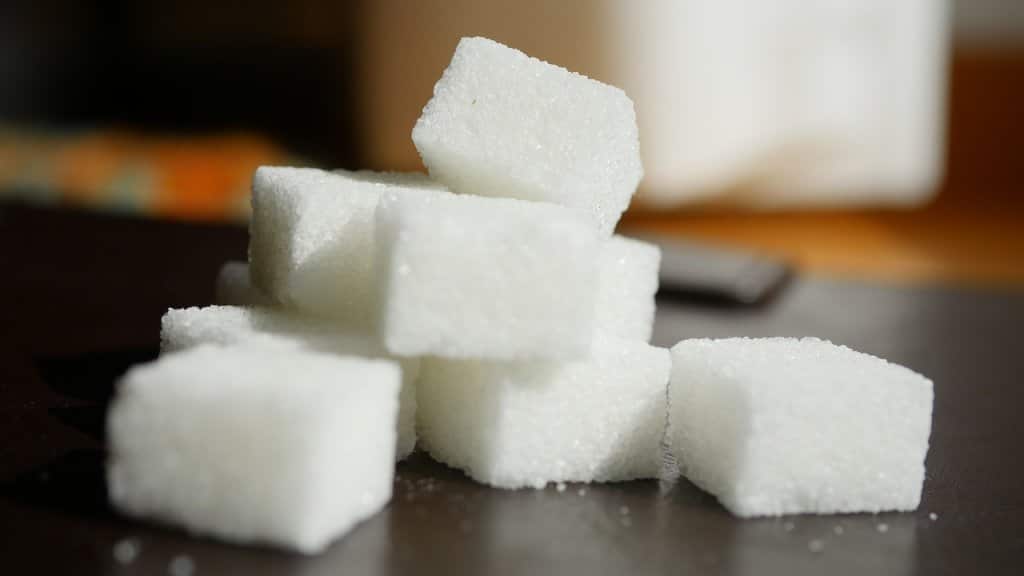
Discover how fructose can elevate uric acid and trigger a gout attack. You’ll also learn which fruit and plant foods are low in fructose and which are high in fructose and have to be avoided.
Sugar and Gout
The root cause of gout is hyperuricemia (high uric acid) that can result in urate crystals forming in the joints and surrounding tissue, leading to a gout flare-up or attack.
Unfortunately for us gout sufferers, uric acid is a necessary byproduct of purine metabolism, which purines exist in our bodies’ cells and in the cells of food we eat.
However, another cause of increased uric acid, that you may not be aware of, is too much fructose consumption.
How Fructose Increases Uric Acid
Fructose is a simple sugar (monosaccharide) found naturally in fruit, some vegetables and other natural foods. It is also to be found in table sugar and a whole array of processed foods and drinks, very often in the form of High Fructose Corn Syrup (HFCS), which is manufactured out of corn starch.
Over the last 30 years or so, HFCS has replaced sugar as the sweetener of choice in soft drinks, being around 1.6 times sweeter than sugar.
Fructose is not a purine, but when too much fructose is ingested, it can raise uric acid levels in several ways:
- When fructose breaks down, it produces lactic acid. Studies have found a link between increased lactic acid and a decrease in uric acid excretion.
- Too much fructose can lead to insulin resistance, which is linked to decreased uric acid excretion.
- It has been discovered that when the liver has to deal with too much fructose, it results in elevated uric acid.
- Fructose increases the breakdown of ATP (adenosine triphosphate), a molecule in the body, which is the primary source of energy for the cells. It is also a purine so, as it breaks down, even more uric acid is produced.
Don’t forget that too much sugar also causes weight gain and we know that being overweight is one of the highest risk factors for elevated uric acid and gout.
Most processed foods and drinks contain added sugar
The problem is that, apart from the obvious sugars like table sugar, honey, etc., there’s a surprisingly large number of sugar-containing foods that many of us may be oblivious to.
Here’s a short list of sugar-containing food and drinks to avoid or, at the very least, severely limit:
- fizzy drinks
- soft drinks
- juice drinks
- vitamin and energy drinks
- table sugar
- jam
- honey
- candies / sweets
- cakes
- cake mixes
- puddings
- biscuits
- pastries
- ice-cream / milk shakes / frozen yogurt
- grains (which turn into sugar in your body)
- processed foods
- canned foods
- breakfast cereals
- cereal bars
- flavored milks
- ready-made soups
- ready meals
- pies
- ready-made sauces (tomato, barbecue, spaghetti, etc.)
- dressings
- ready-made puddings
- dried fruit
- canned or packaged fruit
- food marketed as “reduced fat” since they usually have added sugar to mask the lack of flavor.
This list is nowhere near complete, so be sure to check food labels for their sugar content.
But sugar is very often disguised under a wide variety of names. Keep a look out for the following:
Identifying Sugar on Food Labels
- agava nectar
- barley malt
- beet sugar
- brown sugar
- buttered syrup
- cane juice
- cane juice crystals
- cane juice solids
- caramel
- carob syrup
- corn syrup
- corn syrup solids
- date sugar
- dehydrated cane juice
- dehydrated fruit juice
- dextran
- dextrin
- dextrose
- diatase
- diatastic
- ethyl
- fructose
- fruit juice
- fruit juice concentrate
- fruit juice crystals
- galactose
- glucose
- glucose solids
- golden syrup
- high fructose corn syrup
- maltodextrin
- maltol
- maltose
- malt syrup
- maple syrup
- refiner’s syrup
- sorghum syrup
- sucrose
- turbinado
- yellow sugar
…and anything else that ends in “ose.”
However, your body needs some sugar.
Your body needs a certain amount of natural sugar for energy. Such sugars occur in carbohydrate-rich foods like grains, beans, nuts, vegetables, and fruit.
As well as energy-producing natural sugars, plant foods also have high amounts of fiber, essential minerals, and antioxidants.
So balanced amounts from these natural sources are important for your long-term health.
On the other hand, added fructose in the likes of table sugar, sugary drinks and sodas, and sugar-laden processed foods are bad for your health and should be avoided like the plague.
But what if you suffer with gout?
Okay, so grains, beans, nuts, vegetables, and fruit are important for long-term health. But what if you are a gout sufferer struggling to keep your uric acid at healthy levels (below 6 mg/dL) and even a small change in uric acid could trigger a gout flare-up?
For us with gout, it’s all about balance: balancing the nutritional benefits of foods like grains, beans, nuts, vegetables, and fruit, against the increased risk of a gout attack due to their fructose content.
Here are some issues to consider:
- In general, whole fruits have more fructose than plant foods.
- Dried, canned, and fruit juices have even more fructose than whole fruits.
- Different fruits have different fructose concentrations.
- Different plant foods have different fructose concentrations.
Low Fructose Foods
These fruits are relatively low in fructose: avocado, blueberries, cantaloupe, grapefruit, honeydew melon, lemon, lime, nectarine, orange, pineapple, plum, raspberries, strawberries, sour or tart cherries.
And bok choy, brussels sprouts, cabbage, carrots, cauliflower, chives, kale, lettuce, parsnips, spinach, sweet potatoes, turnip greens, white potatoes, and winter squash are all low-fructose plant foods.
High Fructose Foods
These are relatively high in fructose: apple, banana, blackberries, grapes, kiwi fruit, mango, passion fruit, pear, plantain, pomegranate, sweet cherries, watermelon and, of course, dried fruits.
Plant foods, such as artichokes, asparagus, broccoli, okra, mushrooms and sugar snap peas, also have high fructose concentrations.
But it’s not just fructose you need to consider.
You can’t decide which fruit and plant foods to include in your gout diet based on their fructose content alone, you also have to factor-in their purine content. In other words, it’s no use eating low-fructose foods if they also happen to be high-purine foods.
In terms of fruit, you’re in luck, because fruit is considered to be a low-purine food.
But with plant foods the picture is more varied. For example, cauliflower and spinach are low-fructose foods that are moderately high in purines, so have to be eaten, well, in moderation.
What isn’t in doubt, though, is to severely limit or, better still, completely avoid prepackaged, processed foods, sugary sodas, and fruit juices. These have no health benefits and add a great deal of unwanted fructose into your diet.
So stick to moderate amounts of fresh, low-fructose foods and try to keep your total fructose consumption under 25 grams per day. As my dad used to say; everything in moderation.



